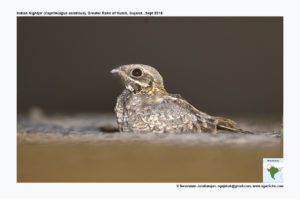
Indian Nightjar Caprimulgus asiaticus
Etymology:
- Caprimulgus : Latin word capra – goat; mulgere –to milk . The nightjar were assumed to drink goats milk and injure the goats
- Asiaticus : From Asia
Vernacular Names :Hindi:SamanyaBhartiyaChapka, Pun: Chhotinehrni, Guj: Deshichhapo, Nanudasharadhiyu, Ta: Padukaikuruvi, Kuruttupakshi, Te: Askapperagadu, Kan: Nattinga, Sinh: Bin bassa, Mar: SamanyaBhartiyaRatva
Distribution in India: Widespread resident except in North West and North east of India.
Description: Size of 23-24cm. They are sexually dimorphic. The upperparts greyish brown streaked blackish brown, crown broadly streaked blackish brown edged rufous; broad buff or tawny nuchal collar; lesser coverts greyish brown speckled rufous, rest of wing-coverts greyish brown boldly spotted buff; scapulars blackish brown edged buff; whitish submoustachial stripe and large white patch on either side of lower throat; underparts greyish brown, barred brown and boldly spotted buff, becoming buff barred brown on belly and flanks. The male has white spot on four outermost primaries and broad white tips to two outermost tail feathers; female has smaller white wing spots, tinged or edged buff, and narrower buffish white tips to two outermost tail feathers, Iris dark brown, bill horn-brown to blackish, legs and feet brownish pink.Found in scrub land or wooded country, scrub jungle, thin bamboo jungle, young forestry plantations, fallow cultivation with thickets and euphorbia hedges, stony nullahs near cultivation, and overgrown gardens. It is found from sea-level to 1500 m.
Food Habits: It eats moths, helipterums, flying ants, grasshoppers, locusts, cockroaches, small wasps, termites and other insects.In non-breeding season also eats flowers and Mice. Nightjars are most active, and mostly feed, near dawn and dusk (crepuscular – active during the twilight). At dusk, they often fly around livestock to feed on insects swarming around the animals. At night, they like to take advantage of insects swarming around street lamps or other artificial light sources. They are keeping their bills wide open as they fly through clouds of small insects. It may also forage under the canopy by flying from favored perches catching insects at foliage. Larger insects are usually taken back to their favored feeding perches. While holding the insects in their bills, it keeps the head upright, shake and swallow the prey whole, or they may break the insects apart before eating. Insects may also be taken from the ground or foliage.
Breeding Habits: They breed in Feb-Sept in India.The nest-site is in open or shaded by vegetation, usually close to bush or tree stump, beneath tree or sapling; no nest, eggs laid on leaf litter, bare ground, or scrape in the ground. They lay a clutch of 1-2 pale eggs ,laid at 1–2-day intervals. The incubation period is 16-19 days, commenced with last egg done by female alone. The male sometimes taking turns close to dusk and dawn. The fledging happens in 17 days.